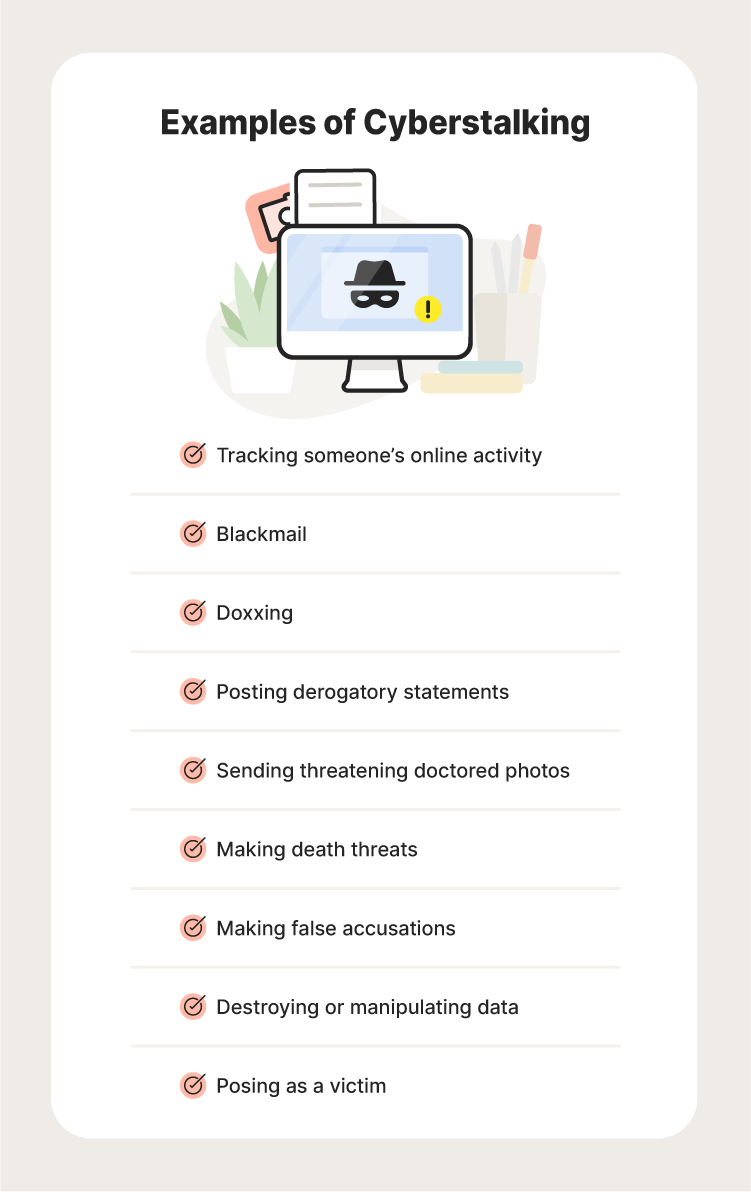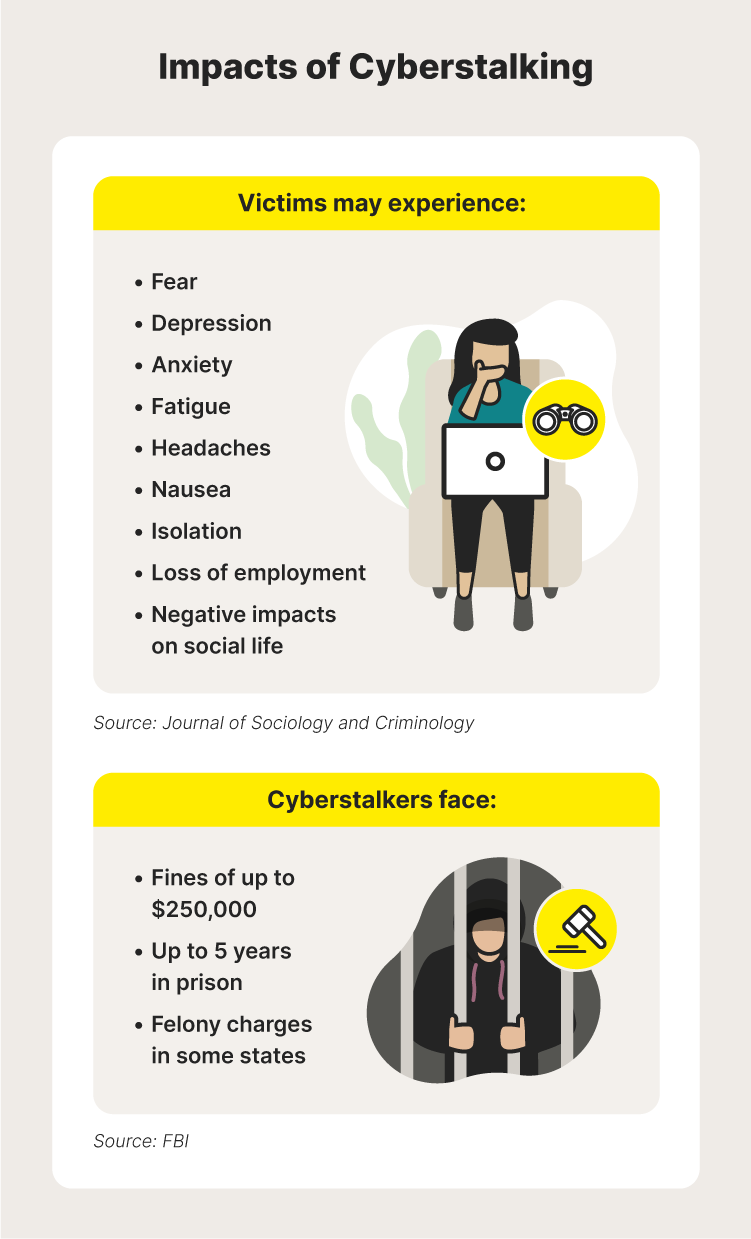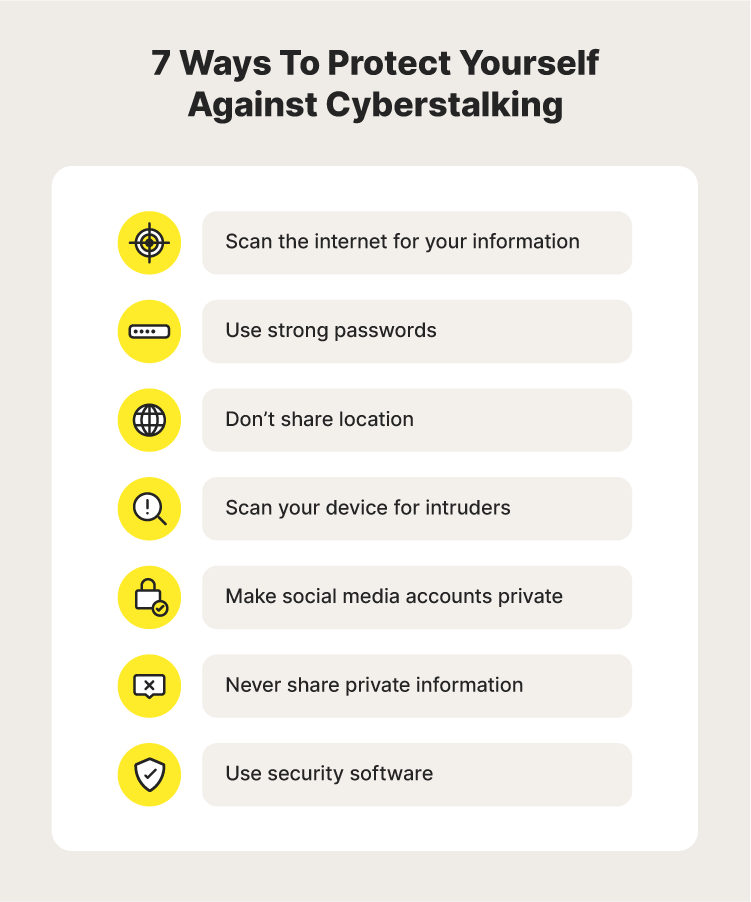Cyberstalking: What it is and how to protect yourself
Cyberstalking is a problem that can impact anyone who uses the internet. This guide will cover what cyberstalking is, how to protect yourself, and how to report these crimes. Use a cybersecurity tool like Norton 360 Deluxe to help protect your privacy, encrypt your communications, and defend against spyware.

Cybersecurity statistics show that 20% of people believe their romantic partner could plant cyberstalking programs on their phones. That number shows just how prevalent this type of cybercrime is.
Learn what cyberstalking is, the consequences of it, the laws in place to protect victims, and how to protect yourself from cyberstalking.
What is cyberstalking?
Cyberstalking is when a cybercriminal uses email, direct messaging, or other electronic means to harass, scare, or threaten someone with physical harm. It takes different forms, including:
- Tracking someone’s online activity or physical location
- Stealing someone’s identity for financial gain
- Making death threats or other overt threats of violence
- Blackmailing a victim using personal information or photos
- Making false accusations about a victim online
- Doxxing a victim by publishing their private information online
- Destroying or manipulating incriminating data by sending a virus to a victim’s devices
- Posting derogatory statements about a victim publicly
- Posing as a victim online to cause harm to their life or career
- Sending threatening doctored photos or deepfakes of the victim or their family

Consequences of cyberstalking
For victims of cyberstalking, the effects don’t stop when they close their browsers or turn off their phones. The negative impacts range from psychological to physical, and can include:
- Fear
- Depression
- Anxiety
- Fatigue
- Headaches
- Nausea
- Isolation
If a cyberstalker impersonates someone or shares embarrassing information—like sensitive pictures or videos—it can negatively impact their relationships with friends and family. That can make it more difficult for them to keep or find employment, or live a fulfilling public life.
When cyberstalkers are caught and prosecuted, they face fines of up to $250,000 and as many as five years imprisonment. In some states, convicted cyberstalkers may lose access to firearms.

Cyberstalking examples
It’s easy to conjure an image of a cyberstalker as a secretive hacker in a dark room, but the truth is that many kinds of people from all walks of life become cyberstalkers or are victims of cyberstalking. Let’s take a look at some recent, real-world examples of cyberstalking:
Cyberstalking example #1: A former eBay executive pleaded guilty to several crimes related to harassing a Massachusetts couple, aiming to get them to stop the publication of a newsletter about eBay sales. The cyberstalking campaign included public tweets, threatening direct messages on Twitter, and going to the couple's home to put a GPS tracker on their car.
The cyberstalker also sent disturbing items to the victims' address, according to the U.S. Department of Justice. These deliveries included a funeral wreath, a book on surviving the death of a spouse, and a bloody pig mask.
Cyberstalking example #2: After a woman turned him down for a romantic relationship, a Texas man cyberstalked her using more than 100 social media accounts to send threatening messages to her and to another victim he “saw as a romantic rival," according to the DOJ.
The cyberstalking campaign, which lasted more than six months, included using social media accounts to send death threats to the victim and publishing her name, address, and other private information online. He also sent her threatening photos.
Cyberstalking laws
Cyberstalking is illegal in the United States, but there aren’t many federal protections. The few that do exist include:
- Combat Online Predators Act: A law that increased the maximum prison sentence for perpetrators who stalk minors online.
- Title 18 : An anti-stalking law prohibiting various forms of stalking, including using electronics to cause physical harm or emotional distress.
- Violence Against Women Act (VAWA): This act aims to help protect women from violence and harassment. In 2022, lawmakers added new prevention and prosecution measures.
Many laws protecting citizens from cyberstalking are written at the state level, so contact your local law enforcement agency if you’re unsure of your rights.
How to help protect yourself against cyberstalking
Preventing cyberstalking means taking proactive steps to keep your information from falling into the wrong hands. Shield yourself and your family from cyberstalkers by following these important tips to help protect your privacy online:
- Conduct a scan for your information: Do an online search for your family’s names to see what information is available about your family online. If you find personal information you wouldn't want a cyberstalker to get, contact the website to remove the data.
- Use strong passwords: Safeguard your accounts with good password security habits. Consider using Norton Password Manager to make it easier to secure and keep track of all your passwords.
- Don’t share locations: Be careful about publicly sharing information that lets a cyberstalker know where you are. This includes "checking in" somewhere on social media or publicly announcing plans to attend a certain event. If you post photos online via social networks or other methods, be sure to turn off the location services metadata in the photo.
- Scan your device for intruders: Cyberstalkers who get their hands on one of your devices can quickly and easily install hardware or malware (sometimes called stalkerware or spyware) to monitor a victim's every online move or track their physical location by phone.
- Set social media to private: Use privacy settings on social media so you’re only sharing posts with close friends, relatives, and others in your trusted circle. Privacy settings can help prevent your profile from appearing in results when others search online for your name.
- Never share private information: Don’t share your full name, address, phone number, full date of birth, email address, or the city you live in with anyone you don’t know personally.
- Use security software: Security software like Norton 360 Deluxe alerts you to threats like phishing attacks in real time, and scans your device to find and remove malware. While it’s not a guarantee against cyberstalking, it’s a big step towards helping to keep you and your family safer.

How to report cyberstalking
If you encounter someone who’s cyberstalking another person, or you’re receiving threats, report it to the police immediately. Many police departments have cybercrime units that are trained to handle online crimes. In other instances, before contacting the authorities, here are a few steps to take:
- Scan your device for spyware or other malware installed by a hacker.
- Keep copies of any messages or images that prove the harassment.
- Log the dates and times you received messages.
- Report the cyberstalker if they escalate or you feel your safety is threatened.
The Federal Bureau of Investigation (FBI) runs the Internet Crime Complaint Center (IC3). In addition to contacting your local police, you can file a complaint online to report cyberstalking and other cybercrimes to the FBI.

Stop cyberstalkers in their tracks
People, including stalkers, are becoming more tech-savvy. Help protect your privacy by encrypting your communications, detecting and eliminating spyware, and keeping your devices safer from hackers with Norton 360 Deluxe.
FAQs about cyberstalking
Have questions about cyberstalking? Here are some answers.
Is it cyberstalking to follow someone on social media and look through their pictures and posts?
Many people use the phrase “stalking” to describe following someone’s activities via their social networks and diving deeply into their profiles in a way they don’t always do. But checking in on an ex-partner or scrolling through your friend’s likes isn’t a crime, because those actions usually don’t involve harassment or other criminal activity.
Why is cyberstalking a crime?
Harassing or threatening someone in person has legal consequences, and so does committing these acts online. Stalking online is legally distinct from stalking in the real world, but both have laws preventing them.
How serious is cyberstalking?
Cyberstalking is always serious, no matter how far the cyberstalker goes to harass the victim. Posting mean comments, though not a crime, can have a lasting psychological impact. However, if the comment does threaten the person or the cyberstalker plans to escalate their actions, this is a more serious crime on par with threatening someone in person.
Is cyberstalking the same as cyberbullying?
Cyberstalking isn’t necessarily the same as cyberbullying. Cyberbullying doesn’t always rise to the level of stalking because it can be as simple as making rude remarks about someone else. But if the bully begins directly harassing someone or threatening them, it could become a case of cyberstalking.
Editorial note: Our articles provide educational information for you. Our offerings may not cover or protect against every type of crime, fraud, or threat we write about. Our goal is to increase awareness about Cyber Safety. Please review complete Terms during enrollment or setup. Remember that no one can prevent all identity theft or cybercrime, and that LifeLock does not monitor all transactions at all businesses. The Norton and LifeLock brands are part of Gen Digital Inc.







Want more?
Follow us for all the latest news, tips, and updates.